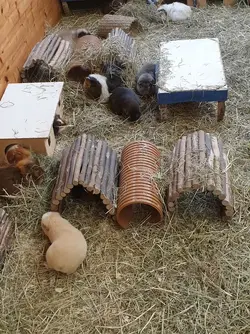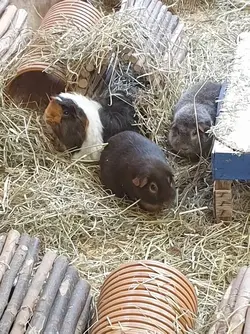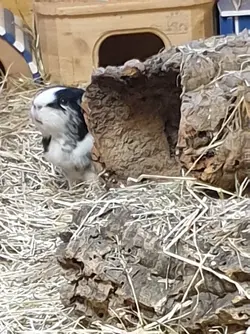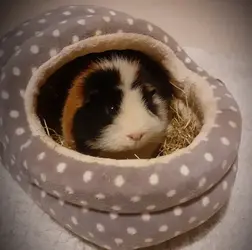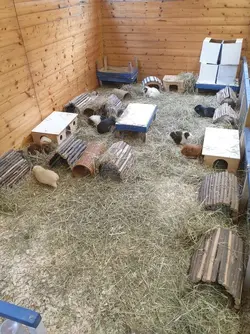ScrufflesRules
Forum Donator 2024/25
This is going to be a long post I'm afraid, it's pretty much all my hypothetical guinea pig questions.
Over the past year, I've been wondering about ways in which I could incorporate ideas from the hamster care world into my (very distant future) guinea pig care. I was wondering if anyone had any experiences/thoughts on the following:
Enrichment items such as cork logs, or maybe even grapevine wood branches or flat stones/pieces of slate: Rodipet® Cork Tunnel size L ca 25 cm long and 12-15 cm in Diameter
Additional substrates, such as compost and shredded toilet paper, or cork granules/ coconut husk. This is a big thing in the hamster world, but I'm not sure whether guinea pig respiratory systems could cope with additional substrates such as coco coir, or even sand?
'Sprays' in the enclosure (Hamsters), although I'm not sure how this would work nutritionally, and they would probably be destroyed very quickly.
Multi-chamber hideouts, to replicate burrow systems. I haven't seen any on the market big enough for guinea pigs, but here's the one my hamster uses to give you an idea of what they look like: Hamster Chamber House - Formaldehyde Free, Non Toxic, Wooden, Slot Together & Mo | Happy Henry’s Homes
This next one is something I might try out a few decades down the line if I ever have enough time, space and money. From what I remember, wild guinea pigs inhabit abandoned burrows (please correct me if I'm wrong). Would it be possible to make some sort of abandoned burrow system under a really deep layer of substrate for domestic guinea pigs? Do you think they would appreciate this, and could it cause health issues?
Would guinea pigs find a 'digging box' enriching? I know that some rabbit/rat owners have a large (1m by 50cm by 50cm) box filled with substrates such as aspen chips or compost which their pets can access to dig in. I believe it's particularly popular with rabbits (but obviously they're naturally burrowing animals).
Anyway, I think that's all my questions for now? I might just use this as my dedicated naturalistic enclosure thread, as I'm sure I'll think of some more questions soon...
Thanks in advance if anyone has any answers or ideas.
Over the past year, I've been wondering about ways in which I could incorporate ideas from the hamster care world into my (very distant future) guinea pig care. I was wondering if anyone had any experiences/thoughts on the following:
Enrichment items such as cork logs, or maybe even grapevine wood branches or flat stones/pieces of slate: Rodipet® Cork Tunnel size L ca 25 cm long and 12-15 cm in Diameter
Additional substrates, such as compost and shredded toilet paper, or cork granules/ coconut husk. This is a big thing in the hamster world, but I'm not sure whether guinea pig respiratory systems could cope with additional substrates such as coco coir, or even sand?
'Sprays' in the enclosure (Hamsters), although I'm not sure how this would work nutritionally, and they would probably be destroyed very quickly.
Multi-chamber hideouts, to replicate burrow systems. I haven't seen any on the market big enough for guinea pigs, but here's the one my hamster uses to give you an idea of what they look like: Hamster Chamber House - Formaldehyde Free, Non Toxic, Wooden, Slot Together & Mo | Happy Henry’s Homes
This next one is something I might try out a few decades down the line if I ever have enough time, space and money. From what I remember, wild guinea pigs inhabit abandoned burrows (please correct me if I'm wrong). Would it be possible to make some sort of abandoned burrow system under a really deep layer of substrate for domestic guinea pigs? Do you think they would appreciate this, and could it cause health issues?
Would guinea pigs find a 'digging box' enriching? I know that some rabbit/rat owners have a large (1m by 50cm by 50cm) box filled with substrates such as aspen chips or compost which their pets can access to dig in. I believe it's particularly popular with rabbits (but obviously they're naturally burrowing animals).
Anyway, I think that's all my questions for now? I might just use this as my dedicated naturalistic enclosure thread, as I'm sure I'll think of some more questions soon...
Thanks in advance if anyone has any answers or ideas.
